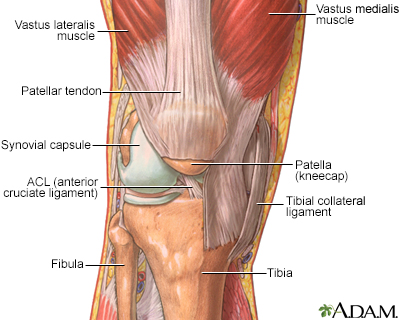Definition
Joint pain can affect one or more joints.

Alternative Names
Stiffness in a joint; Pain - joints; Arthralgia; Arthritis
Causes
Joint pain can be caused by many types of injuries or conditions. It may be linked to arthritis, bursitis, and muscle pain. No matter what causes it, joint pain can be very bothersome. Some things that can cause joint pain are:
- Autoimmune diseases such as rheumatoid arthritis and lupus
- Bursitis
- Chondromalacia patellae
- Crystals in the joint -- gout (especially found in the big toe) and CPPD arthritis (pseudogout)
- Infections caused by a virus
- Injury, such as a fracture
- Osteoarthritis
- Osteomyelitis (bone infection)
- Septic arthritis (joint infection)
- Tendinitis
- Unusual exertion or overuse, including strains or sprains
Signs of joint inflammation include:
- Swelling
- Warmth
- Tenderness
- Redness
- Pain with movement
Home Care
Follow your health care provider's advice for treating the cause of the pain.
For non-arthritic joint pain, both rest and exercise are important. Warm baths, massage, and stretching exercises should be used as often as possible.
Acetaminophen (Tylenol) may help the soreness feel better.
Nonsteroidal anti-inflammatory drugs (NSAIDs) such as ibuprofen or naproxen may help relieve pain and swelling. Talk to your provider before giving aspirin or NSAIDs such as ibuprofen to children.
When to Contact a Medical Professional
Contact your provider if:
- You have fever that is not associated with flu symptoms.
- You have lost 10 pounds (4.5 kilograms) or more without trying (unintended weight loss).
- Your joint pain lasts for more than several days.
- You have severe, unexplained joint pain and swelling, particularly if you have other unexplained symptoms.
What to Expect at Your Office Visit
Your provider will ask you questions about your medical history and symptoms, including:
- Which joint hurts? Is the pain on one side or both sides?
- What started the pain and how often have you had it? Have you had it before?
- Did this pain begin suddenly and severely, or slowly and mildly?
- Is the pain constant or does it come and go? Has the pain become more severe?
- Have you injured your joint?
- Have you had an illness, rash, or fever?
- Does resting or moving make the pain better or worse? Are certain positions more or less comfortable? Does keeping the joint elevated help?
- Do medicines, massage, or applying heat reduce the pain?
- What other symptoms do you have?
- Is there any numbness?
- Can you bend and straighten the joint? Does the joint feel stiff?
- Are your joints stiff in the morning? If so, for how long does the stiffness last?
- What makes the stiffness better?
A physical exam will be done to look for signs of joint abnormality including:
- Swelling
- Tenderness
- Warmth
- Pain with motion
- Abnormal motion such as limitation, loosening of the joint, grating sensation
Tests that may be done include:
- Complete blood count (CBC) or blood differential
- C-reactive protein
- Joint x-ray
- Sedimentation rate
- Blood tests specific to various autoimmune disorders
- Joint aspiration to obtain joint fluid for culture, white cell count and examination for crystals
Treatments may include:
- Medicines such as non-steroidal anti-inflammatory drugs (NSAIDs) including ibuprofen, naproxen, or indomethacin
- Injection of a corticosteroid medicine into the joint
- Antibiotics and often surgical drainage, in case of infection (usually require hospitalization)
- Physical therapy for muscle and joint rehabilitation
References
Bykerk VP, Crow MK. Approach to the patient with rheumatic disease. In: Goldman L, Schafer AI, eds. Goldman-Cecil Medicine. 26th ed. Philadelphia, PA: Elsevier; 2020:chap 241.
Davis JM, Moder KG, Hunder GG. History and physical examination of the musculoskeletal system. In: Firestein GS, Budd RC, Gabriel SE, Koretzky GA, McInnes IB, O'Dell JR, eds. Firestein & Kelley's Textbook of Rheumatology. 11th ed. Philadelphia, PA: Elsevier; 2021:chap 43.
Version Info
- Last reviewed on 1/16/2022
- Diane M. Horowitz, MD, Rheumatology and Internal Medicine, Northwell Health, Great Neck, NY. Review provided by VeriMed Healthcare Network. Also reviewed by David Zieve, MD, MHA, Medical Director, Brenda Conaway, Editorial Director, and the A.D.A.M. Editorial team.
 A.D.A.M., Inc. is accredited by URAC, also known as the American Accreditation HealthCare Commission (www.urac.org). URAC's accreditation program is the first of its kind, requiring compliance with 53 standards of quality and accountability, verified by independent audit. A.D.A.M. is among the first to achieve this important distinction for online health information and services. Learn more about A.D.A.M.'s editorial process. A.D.A.M. is also a founding member of Hi-Ethics (www.hiethics.com) and subscribes to the principles of the Health on the Net Foundation (www.hon.ch).
A.D.A.M., Inc. is accredited by URAC, also known as the American Accreditation HealthCare Commission (www.urac.org). URAC's accreditation program is the first of its kind, requiring compliance with 53 standards of quality and accountability, verified by independent audit. A.D.A.M. is among the first to achieve this important distinction for online health information and services. Learn more about A.D.A.M.'s editorial process. A.D.A.M. is also a founding member of Hi-Ethics (www.hiethics.com) and subscribes to the principles of the Health on the Net Foundation (www.hon.ch).
The information provided herein should not be used during any medical emergency or for the diagnosis or treatment of any medical condition. A licensed physician should be consulted for diagnosis and treatment of any and all medical conditions. Call 911 for all medical emergencies. Links to other sites are provided for information only -- they do not constitute endorsements of those other sites. Copyright 2002 A.D.A.M., Inc. Any duplication or distribution of the information contained herein is strictly prohibited.